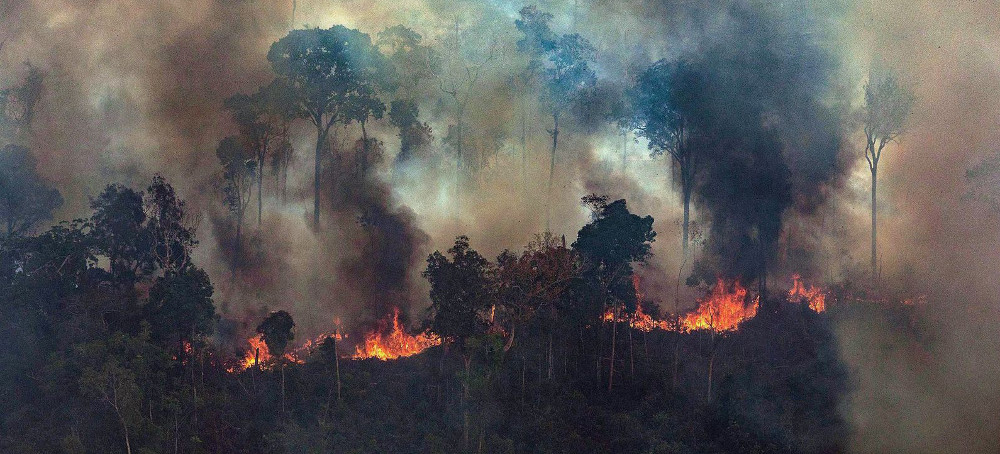Here's a Realistic Path to Protecting the Amazon Rainforest
The Washington Post Editorial Board A historic drought and record wildfires are ravaging the Amazon rainforest. (photo: Michael Dantas/AFP)
A historic drought and record wildfires are ravaging the Amazon rainforest. (photo: Michael Dantas/AFP)
That loss would be felt far beyond the rainforest’s borders. The Amazon’s “flying rivers” — clouds of water vapor that are transported across South America — drive precipitation in the region and are vital for food systems. Moreover, the 150 billion metric tons of carbon stored in the Amazon’s trees and soil would be, if fully released back into the atmosphere as the forest dies, more than a decade’s worth of global fossil fuel emissions.
The rainforest encompasses about 40 percent of South America’s land mass. Though reported deforestation rates have fallen since the right-wing Brazilian president Jair Bolsonaro left office, protecting such a vast area against people with strong incentives to degrade it is hard. But not impossible.
Making deforestation less lucrative
To save forests, governments need to set regulations on land use — and then enforce them. In the case of the Amazon, much of the responsibility falls on Brazil, which is home to approximately 60 percent of the forest and has experienced big political swings in recent years.
A working paper by economists Robin Burgess, Francisco Costa and Benjamin A. Olken shows those shifts affected deforestation. Drawing on satellite data along Brazil’s national border, the researchers found that at the turn of the century the level and rate of deforestation on the Brazilian side were significantly higher than in neighboring countries. In 2006, as the Brazilian government implemented policies to reduce illegal deforestation, these differences disappeared — only to return as regulations were dismantled less than a decade later.
This means that Brazil already has a playbook to help protect the Amazon. Punishing rule-breakers, bolstering the ranks of enforcement officers, setting guidelines for sustainable development and conditioning credit on compliance could all move the needle. Yet Brazil needs to do more than return to the policies of a decade ago.
One area to target is Brazil’s heavily subsidized cattle industry. Some estimates suggest that 70 percent of the Amazon’s deforested land has been converted to pastures for cattle grazing and ranching — all while meat producers receive tax incentives, debt forgiveness and credit worth more than $2 billion annually. Tying these incentives to producing beef more efficiently could reduce some of the pressures to convert forests.
Another issue is the global demand for soybeans, which are a feedstock for biofuel production. Many governments, including those of the United States and the European Union, have promoted biofuel usage, ostensibly to reduce greenhouse gas emissions. In reality, biofuels are costly and inefficient, prompting the conversion of forests into cropland. Shifting toward strategies such as promoting efficiency, renewables deployment and clean-energy research would help preserve a major source of land-based carbon capture.
Policymakers around the world have also explored eco-labels identifying goods that were produced by illegal deforestation. But the certification system needs to become less confusing to consumers, and key auditors need to better account for environmental damage in the production process.
Offering incentives for conservation
People don’t just need to be encouraged to scale back the chopping down of the forest. They also need to be encouraged to save what is left. Razing forests to build infrastructure or create more agricultural land creates income — whereas the benefits of conservation feel more distant and less material.
Incentives for conservation could generate greater local buy-in and contribute to global anti-poverty goals. In Uganda, a randomized experiment by Seema Jayachandran, a Princeton University professor and an affiliate at the Abdul Latif Jameel Poverty Action Lab, and other researchers, found that “payments for ecosystem services” resulted in significantly less deforestation in villages eligible for the program. This was also cost-effective, with the benefits to society from delaying carbon entering the atmosphere exceeding the costs.
These types of programs are most viable in areas with high deforestation and where there are well-defined land rights — a challenge in a region where land tenure is often murky and an estimated 29 percent of the Brazilian Amazon is “undesignated.” Satellite data can make robust monitoring viable at scale. Similar contracts could also be made with Indigenous groups, supporting their stewardship of the forest.
In a related, though slightly different, approach, governments could offer incentives to landowners for improving capacity and output on existing cropland. Performance-based funding, a method that initiatives such as Brazil’s Amazon Fund already employ, would ensure communities can still farm, but in a way that generates more with less. Targeted restoration projects of key degraded lands also have potential.
Of course, all of this would require consistent funding — from regional governments as well as foreign partners. Developed countries benefit from the Amazon’s environmental impact and should contribute to its protection via climate finance agreements. Private capital should also play a role: Princeton’s Tim Searchinger points out that this is especially true of the aviation and maritime sectors, which are under pressure to reduce emissions but struggle with the exorbitant costs of switching fuels within their industries. Airlines and shippers could help preserve the Amazon to offset the emissions they are likely to produce in coming decades. This would require a transparent, trusted mechanism to ensure public and private funding are going toward conservation, rather than scam environmental projects or ecological initiatives that would have happened anyway.
There is, in other words, reason to hope the Amazon can be saved — in a way that doesn’t suppress development but instead reinvigorates the region for decades to come. It won’t be easy. But it’s not impossible.



